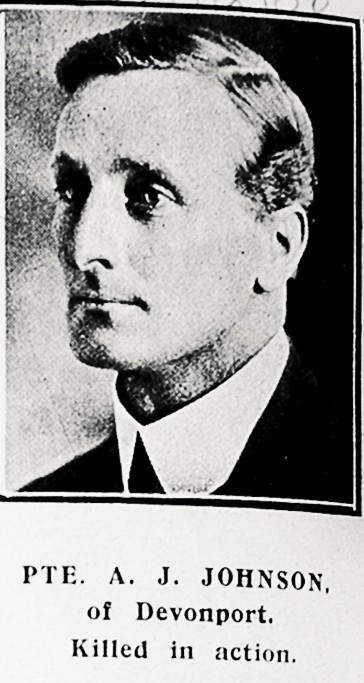Pte
Arthur James Johnson
Informationen zu Geburt
|
Geburtsdatum: 16/07/1885 |
|
Geburtsort: Christchurch, Canterbury, New Zealand |
Allgemeine Informationen
|
Beruf: Arbeiter |
Informationen zum Armeedienst
|
Land: New Zealand |
|
Truppe: New Zealand Expeditionary Force |
|
Rang: Private |
|
Dienstnummer: 54886 |
|
Einberufung datum: 12/02/1917 |
|
Einberufung ort: Auckland, Auckland, New Zealand |
|
Einheiten: — Auckland Infantry Regiment, 3rd Bn. (Letzte bekannte Einheit) |
Informationen zu Tod
|
Sterbedatum: 31/12/1917 |
|
Sterbeort: Noordemdhoek, Belgien |
|
Todesursache: Im Kampf gefallen |
|
Alter: 32 |
Begräbnisplatz
|
Polygon Wood Cemetery Grabstelle: / Reihe: G Grab: 20 |
Auszeichnungen und Orden 2
|
British War Medal Medaille |
|
Victory Medal Medaille |
Punkte von Interesse 2
| #1 | Geburtsort | ||
| #2 | Einberufung ort |
Meine Geschichte
Arthur James Johnson was born in Christchurch on 16 July 1885, son of Seldon and Harriett Johnson, immigrants from Devonshire, England. Arthur had one brother, Albert Edward George Johnson, born in 1891.
The Johnson family lived in Nelson and Buller before moving to Auckland. By 1917, when he enlisted on 12 February 1917 in Auckland, Arthur had been working as a labourer in Wellington. He joined the 28th Reinforcement and went into camp on 3 May. He trained at Trentham and Featherston camps before embarking on the troop ship Waitemata on 24 July 1917, arriving in Plymouth on 25 September.
Arthur spent a month training in Sling Camp, England before sailing to France on 26 October 1917. He was briefly at Etaples before being posted to 15th Company, 3rd Battalion, Auckland Infantry Regiment on 9 November 1917.
After the Third Battle of Ypres the New Zealand Division held the line in and around Polygon Wood. In early December the Division wanted to improve its positions and tried to take the heights round Polderhoek Chateau.
The Division’s battalions relieved each other in the Polygon Wood sector, the main work being improving defences, repairing trenches and wire. The landscape was water-filled shell holes. The Germans had observation over much of the area so any movement was shelled or machine-gunned.
Soon after Arthur joined 3rd Auckland Battalion, it went into the line at Noordemdhoek, north-east of Polygon Wood. On 22 November the Battalion went back to Half-way House near Zillebeke, being used for work parties. It again went the line on 14 December at Noordemdhoek, shortly before snow and frost struck the battlefield. On 22 December It repeated the withdrawal to Half-way House to supply labour. It was at the front again from 29 December to 2 January 1918 and it was in this period of service that Arthur Johnson was killed. The regimental history does not give much detail for this period so it is difficult to say how Arthur died.
Arthur Johnson was buried at Crucifix Cemetery near Polygon Butte and later placed in Polygon Wood Cemetery, Row G, Grave 20.
The Johnson family lived in Nelson and Buller before moving to Auckland. By 1917, when he enlisted on 12 February 1917 in Auckland, Arthur had been working as a labourer in Wellington. He joined the 28th Reinforcement and went into camp on 3 May. He trained at Trentham and Featherston camps before embarking on the troop ship Waitemata on 24 July 1917, arriving in Plymouth on 25 September.
Arthur spent a month training in Sling Camp, England before sailing to France on 26 October 1917. He was briefly at Etaples before being posted to 15th Company, 3rd Battalion, Auckland Infantry Regiment on 9 November 1917.
After the Third Battle of Ypres the New Zealand Division held the line in and around Polygon Wood. In early December the Division wanted to improve its positions and tried to take the heights round Polderhoek Chateau.
The Division’s battalions relieved each other in the Polygon Wood sector, the main work being improving defences, repairing trenches and wire. The landscape was water-filled shell holes. The Germans had observation over much of the area so any movement was shelled or machine-gunned.
Soon after Arthur joined 3rd Auckland Battalion, it went into the line at Noordemdhoek, north-east of Polygon Wood. On 22 November the Battalion went back to Half-way House near Zillebeke, being used for work parties. It again went the line on 14 December at Noordemdhoek, shortly before snow and frost struck the battlefield. On 22 December It repeated the withdrawal to Half-way House to supply labour. It was at the front again from 29 December to 2 January 1918 and it was in this period of service that Arthur Johnson was killed. The regimental history does not give much detail for this period so it is difficult to say how Arthur died.
Arthur Johnson was buried at Crucifix Cemetery near Polygon Butte and later placed in Polygon Wood Cemetery, Row G, Grave 20.
Quellen 2
|
Ormond E. Burton, The Auckland regiment N.Z.E.F. : Being an account of the doings on active service of the first, second and third battalions of the Auckland Regiment, (Auckland, Withcombe & Tombs Ltd., 1922), page 182 -185. Verwendete Quellen |
|
Service Records https://www.archway.archives.govt.nz/ViewFullItem.do?code=18053662 Verwendete Quellen |
Weitere Informationen 5
|
Commonwealth War Graves Commission Database https://www.cwgc.org/find-records/find-war-dead/casualty-details/480037 |
|
Namenlijst (In Flanders Fields Museum) https://namenlijst.org/publicsearch/#/person/_id=b6f67d49-1f1a-454a-824e-67faae760ed4 |
|
Lives of the First World War (Imperial War Museum) https://livesofthefirstworldwar.iwm.org.uk/lifestory/7177205 |
|
Online Cenotaph (Auckland Museum) https://www.aucklandmuseum.com/war-memorial/online-cenotaph/record/c7758 |
|
The NZEF Project (UNSW Canberra) https://nzef.adfa.edu.au/showPerson?pid=130587 |
